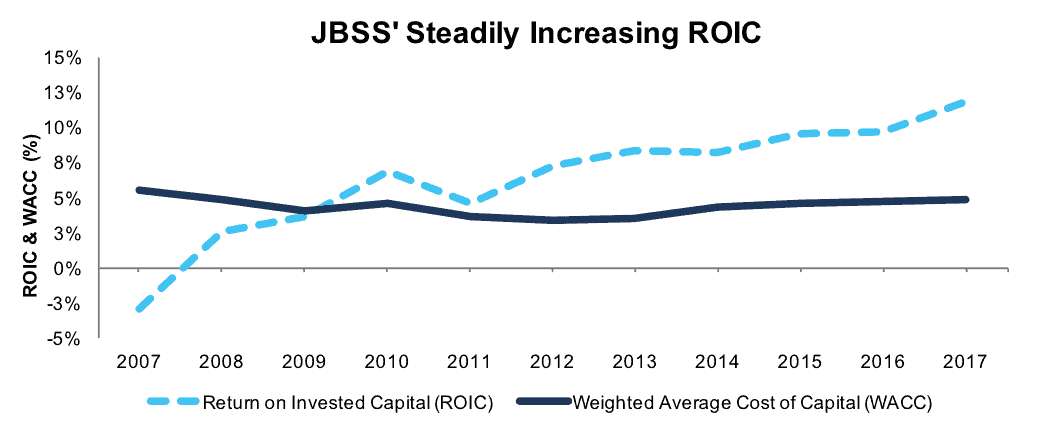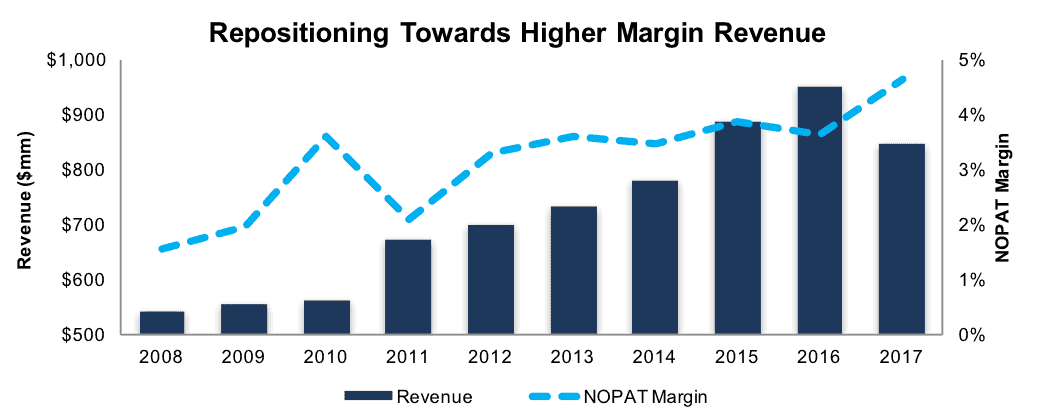Four new stocks make September’s Exec Comp Aligned with ROIC Model Portfolio, available to members as of September 15, 2017.
Recap from August’s Picks
Our Exec Comp Aligned with ROIC Model Portfolio (+2.1%) outperformed the S&P 500 (+1.2%) last month. The best performing stock in the portfolio was Children’s Place (PLCE), which was up 15%. Overall, nine out of the 15 Exec Comp to ROIC Stocks outperformed the S&P in August.
Since inception, this model portfolio is up 19% while the S&P 500 is also up 19%.
The success of this Model Portfolio highlights the value of our Robo-Analyst technology, which scales our forensic accounting expertise (featured in Barron’s) across thousands of stocks.
This Model Portfolio only includes stocks that earn an Attractive or Very Attractive rating and align executive compensation with improving ROIC. We think this combination provides a uniquely well-screened list of long ideas because return on invested capital (ROIC) is the primary driver of shareholder value creation.
New Stock Feature for September: John B. Sanfilippo & Son (JBSS: $65/Share)
John B. Sanfilippo & Son (JBSS), a producer and distributor of agricultural and packaged food products, is one of the additions to our Exec Comp Aligned with ROIC Model Portfolio in September. JBSS was also a featured Long Idea in March 2015 and is up 80% since while the S&P is up just 19% over the same time.
For the past several years, management has focused on transitioning JBSS from an agricultural commodity producer to a branded consumer products company. The strategic focus has yielded favorable results. Since 2012, revenue has grown 4% compounded annually while after-tax profit (NOPAT) has grown 11% compounded annually. This accelerated NOPAT growth is attributable to improving profit margins. Per Figure 1, the firm’s NOPAT margin has increased from 3% in 2012 to 5% over the trailing twelve months (TTM).
Figure 1: JBSS’ Improving NOPAT Margin
Sources: New Constructs, LLC and company filings
Compensation Plan Aligns Executive and Shareholder Interests
JBSS executive’s annual incentive compensation is paid as a cash bonus (30-40% of total comp) based on the Sanfilippo Value-Added Plan (“SVA Plan”). The SVA Plan rewards executives for meeting or exceeding year-over-year improvement targets for economic profit. JBSS defines economic profit as after-tax operating profit minus a capital charge at a 9% cost of capital (WAAC). Invested capital is defined as equity plus debt less excess cash above $2 million.
While the calculation methodology may not be perfect, the focus on economic profit and improving ROIC aligns the interests of executives and shareholders and helps to ensure the prudent stewardship of capital. Per Figure 2, JBSS’s ROIC improved to 12% in 2017 from 7% in 2012 and -3% in 2007. In addition to improving profitability, prudent balance sheet management has also contributed to improving ROIC. Over the past decade, the firm’s ratio of invested capital turns (revenue/invested capital) has increased from a healthy 1.6 to a very healthy 2.6.
Figure 2: JBSS’ Executive Comp Plan Incentivizes ROIC Improvement
 Sources: New Constructs, LLC and company filings
Sources: New Constructs, LLC and company filings
Low Expectations Embedded in Stock Price Provide Attractive Risk/Reward
At its current price of $65/share, JBSS has a has a price-to-economic book value (PEBV) ratio of 1.0. This ratio means the market believes JBSS’ NOPAT has peaked and offers no growth potential from current levels. This expectation seems overly pessimistic for a firm that has generated 11% compound annual NOPAT growth over the past five years and is successfully transitioning to a more stable and profitable business model.
If JBSS can maintain current NOPAT margins (5% TTM) and grow NOPAT by 3% compounded annually over the next decade, the stock is worth $82/share today – a 26% upside. In a more optimistic scenario of 5% compound annual NOPAT growth over the next decade, the stock is worth $100/share today – a 54% upside.
Auditable Impact of Footnotes & Forensic Accounting Adjustments
Our Robo-Analyst technology enables us to perform forensic accounting with scale and provide the research needed to fulfill fiduciary duties. In order to derive the true recurring cash flows, an accurate invested capital, and an accurate shareholder value, we made the following adjustments to John B. Sanfilippo & Son’s 2017 10-K:
Income Statement: we made $8 million of adjustments with a net effect of removing $4 million in non-operating expense (<1% of revenue). We removed $6 million related to non-operating expenses and $2 million related to non-operating income. See all the adjustments made to JBSS’ income statement here.
Balance Sheet: we made $67 million of adjustments to calculate invested capital with a net increase of $44 million. The most notable adjustment was $10 million (3% of reported net assets) related to other comprehensive income. See all adjustments to JBSS’ balance sheet here.
Valuation: we made $83 million of adjustments with a net effect of decreasing shareholder value by $83 million. There were no adjustments that increased shareholder value. The largest adjustment to shareholder value was $22 million in underfunded pensions. This adjustment represents 3% of JBSS’ market cap. Despite the decrease in shareholder value, JBSS remains undervalued.
This article originally published on September 19, 2017.
Disclosure: David Trainer, Kenneth James, and Kyle Guske II receive no compensation to write about any specific stock, style, or theme.
Follow us on Twitter, Facebook, LinkedIn, and StockTwits for real-time alerts on all our research.
